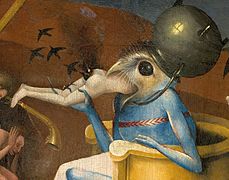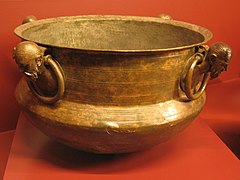Cauldron
This article's lead section may be too short to adequately summarize the key points. (February 2023) |
This section contains an unencyclopedic or excessive gallery of images. |

A cauldron (or caldron) is a large pot (kettle) for cooking or boiling over an open fire, with a lid and frequently with an arc-shaped hanger and/or integral handles or feet. There is a rich history of cauldron lore in religion, mythology, and folklore.
Etymology
The word cauldron is first recorded in Middle English as caudroun (13th century). It was borrowed from Norman caudron[1] (Picard caudron, French: chaudron). It represents the phonetical evolution of Vulgar Latin *caldario for Classical Latin caldārium "hot bath", that derives from cal(i)dus "hot".[1]
The Norman-French word replaces the Old English ċetel (German (Koch)Kessel "cauldron", Dutch (kook)ketel "cauldron"), Middle English chetel. The word "kettle" is a borrowing of the Old Norse variant ketill "cauldron".[2]
History
Cauldrons can be found from the late
Symbolism and mythology

Cauldrons have largely fallen out of use in the
In some forms of

The
The common translation for ding is often referred to as a cauldron. In Chinese history and culture, possession of one or more ancient dings is often associated with power and dominion over the land. Therefore, the ding is often used as an implicit symbolism for power. The term "inquiring of the ding" (Chinese: 问鼎; pinyin: wèn dǐng) is often used to symbolize the use of divination or for the quest for power. One example of the ding cauldron and gaining power over the traditional provinces of China is the Nine Tripod Cauldrons (whether regarded as myth or history).
Archeologically intact actual cauldrons with apparent cultural symbolism include:
- the Gundestrup cauldron, made in the 2nd or 1st century BC, found at Gundestrup, Denmark
- a Bronze Age cauldron found at Hassle, Sweden
- Ceremonial cauldrons from the ancient Armenian state of Urartu
- the cauldron where the Olympic Flame burns for the duration of the Olympic Games
Cauldrons known only through myth and literature include:
- Dagda's Cauldron
- The Cauldron of Dyrnwch the Giant
- Pair Dadeni
- Cauldron of Hymir
Gallery
-
rice
-
A Witches'-caldron table
-
The Garden of Earthly Delights, bird-headed monster or the "Prince of Hell" (close-up head), a name derived from the cauldron he wears on his head.
-
A cauldron pictured in the coat of arms of Padasjoki
-
Mušov cauldron. A Roman bronze cauldron found in 1988 in a Germanic chieftains grave in Mušov, Czech Republic dating to 2nd century AD.
-
African Americanwoman and child outdoors, standing by boiling cauldron of water, c. 1901.
See also
- Chaldron, an obsolete spelling of 'cauldron', an English measure of dry volume.
- Alfet
- Fire pot
- Eldhrímnir
- Gulyásleves
- Hassle
- Kama
- List of cooking vessels
- Olympic flame
- Potjiekos
- Sacrificial tripod
References
- ^ ISBN 0-19-283098-8). p. 67.
- ISBN 0-19-283098-8) p.252.
- ISBN 0-7607-1716-8.
- ISBN 978-0-7083-1953-6.








